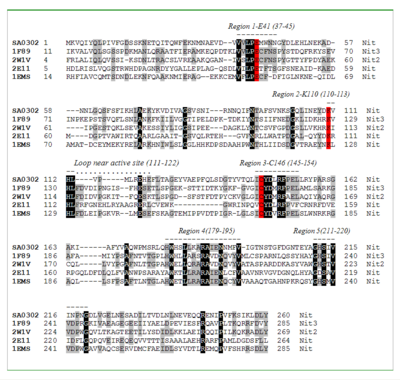Crystal structure of the CN-hydrolase SA0302 from the pathogenic bacterium Staphylococcus aureus belonging to the Nit and NitFhit Branch of the nitrilase superfamily
Roni D. Gordon, Wei Qiu, Vladimir Romanov, Kim Lam, Maria Soloveychik, Diana Benetteraj, Kevin P. Battaile, Yuri N. Chirgadze, Emil F. Pai, and Nickolay Y. Chirgadze [1]
Molecular Tour
The nitrilase, superfamily of protein enzyme, has in total over 180 known members. It includes a variety of thiol amidase enzymes involved in biosynthesis in plants, animals, fungi and prokaryotes [2].
All members of this superfamily have conserved the active site residues Glu-Lys-Cys, believed to form a catalytic triad. The consensus sequences flanking the catalytic residues supply the conserved motifs distinctive for all of the branches [2]. The superfamily can be classified into 13 branches, nine of which have known or predicted specificity for nitrilase, amidase, and CN-hydrolase reactions. Although the entire family has been considered “nitrilase-related”, only members of Branch 1 have demonstrated nitrilase activity. The remaining branches include enzymes with amidase or amide-condensation activity including aliphatic amidase, amino-terminal amidase, biotinidase, β-ureidopropionase, carbamylase, prokaryotic and eukaryotic NAD-synthetase, and apo-lipoprotein N-acyltransferase [3]. Analysis of the sequences and structures of CN-hydrolases with known three-dimensional structures shows that SA0302 definitely is a member of Branch 10 (Nit and NitFhit) of the nitrilase superfamily. Enzyme activities and substrate specificities of members of this branch are not yet characterized, in contrast to those of the members of Branches 1 to 9.
The monomer consists of N-subdomain is colored in salmon and C-subdomain is in magenta. The is formed by the residues from both the N- and C-terminal sub-domains (catalytic residues are labeled). The protein contains 261 amino acids and consists of a four-layer (color-coding: Alpha Helices, Beta Strands , Turns), consistent with the expected CN-hydrolase fold. The , which was found in crystal and solution media, contains two accessible to the solvent active sites. First monomer is colored in green, second monomer is in darkmagenta, positions of catalytic triad residues are in red, and the conserved α6-β10 hairpin is shown in orange.
The sequence alignments of SA0302 with four known nitrilase structures are presented in the image below.
They clearly show the which believed to describe the enzyme active site. These catalytic residues are located within corresponding to their relative locations in the SA0302 protein sequence: region 1 – flanking E41; region 2 – following K110; and region 3 – flanking C146, which also has a protein signature consistent with the 21-residue “nucleophile elbow” motif [4]. These flanking catalytic sequences of SA0302 are in good accordance with consensus sequences of CN-hydrolase of Branch 10 (Nit and NitFhit) of the nitrilase superfamily [2]. On the basis of semi-conserved regions flanking the catalytic triad, we have assigned ten other uncharacterized protein sequences to Branch 10 of the nitrilase superfamily (see image below).
with the catalytic triad. shows that active site includes five participants: catalytic triad Glu41-Lys110-Cys146, water molecule W272, and additional residue Glu119.
In spite of growing interest about the details of the enzymatic mechanism of the members of Branch 10, at present little is known about the specificity of possible substrates or inhibitors. This is a very challenging biochemical problem that is still far from being resolved. At the moment, we can cite one important related reference [5]. In this paper, two murine nitrilases, including Nit1 and Nit2, were identified as targets for a dipeptide-chloroacetamide activity-based probe. The gel analysis of binding of Nit with these probes shows definite selectivity of labeling inside the Nit subfamily. Experimental data of positive labeling are as follows:
Nit1: Leu-Tyr, Leu-His, Leu-Leu, Asp-Leu, Glu-Leu, Tyr-Leu, D-Leu-Asp, Leu-D-Asp, D-Leu-D-Asp, D-Leu-D-Asp
Nit2: Leu-Tyr, Leu-His, Leu-Leu, Leu-Arg, Leu-Glu, Leu-Asp, D-Leu-Asp,
where common dipeptide α-CA probes are in bold.
These data implicate the specificity of substrate binding for a definite member of Branch 10 of the Nit-nitrilase superfamily. The present solution of the substrate-free bacterial protein structure of SA0302 gives the basis for substrate binding studies with the potential substrates or inhibitors.



